There is no getting away from it- we all judge people by the way they dress. It is not that we always consciously want to, but it does give us an idea of the kind of person we are dealing with.
The way someone dresses tells us about their personality, their job, social class, likes, interests and more importantly their beliefs, etc it is a quick way for us to get to know new people. Saudi Arabia is no exception.
So, how must men dress in Saudi Arabia? Like women, men must also dress conservatively. This means they should wear traditional ‘thobe’ or else long trousers, a long-sleeved shirt, and light shoes. Shorts can be worn as long as the waist begins above the belly button and the legs end below the knees. They should avoid wearing bracelets, bangles, and necklaces.
In reality, there are few hard and fast rules. Men can dress pretty much dress how they like, but they must do it in a manner that does not cause offense.
The rest of this article deals with how Muslim men in Saudi Arabia dress and the dress expectations for male visitors and tourists to the kingdom.
Addendum: As of Nov 2019, Saudi authorities are enforcing legislation targeting violations of public decency that include dress, graffiti, and verbal and threatening behavior using spot fines. (See details below)
What are the dress code indicators in Saudi Arabia?
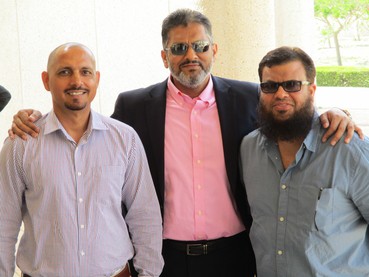
in Semi-Formal Work Dress
In Saudi Arabia, a dress code for men is super important. It not only tells you about someone’s nationality but about the type of work they do, their religion, their educational levels, their class status, their personality, and their beliefs generally. MFS
Who wears what in Saudi Arabia?
In Saudi Arabia, men are instantly recognizable both by the way they look and by the way they dress. When meeting someone for the first time, a couple of things need to be established about the person. Most people are first interested to find out if the person is:
- Saudi or non-Saudi
- Asian, Arab or European/Western
- Professional or non-professional
- Muslim or Non-Muslim
Knowing this will largely determine how you respond and establish your future communication with that person. You can usually tell this by the way they dress, look and speak.

First, you can know a Saudi because he often wears a traditional long white ‘thobe’ and ‘shamag’ (headcloth).
Increasingly today, however, Saudis prefer to wear jeans, shirts, and shirts. Saudis also like to wear leather sandals and fashionable clothes of good quality.
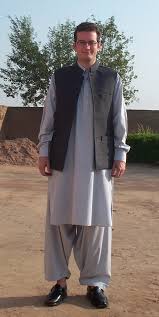
Second, Indians, Pakistanis, and Bangladeshis, on the other hand, make up the biggest expat population in the kingdom. These are the nationalities you will see the most of anywhere in the kingdom.
It is fairly easy to know if they are Saudi or not but often it is difficult to tell them apart in terms of own nationalities.
You can see Indians because they mostly wear semi-formal Western-style pants and shirts. Pakistanis also wear casual attire, but at the weekend you will usually see them wearing the stylish Pakistani Shalwar (loose trousers) and Kameez which is the shirt which extends to the knees. Afghanis wear the Shalwar and Kameez most of the time.
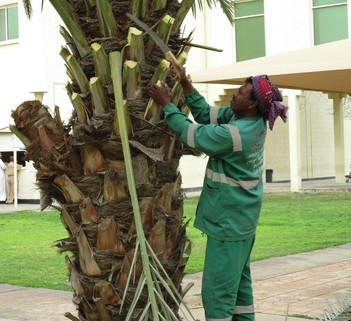
On the other hand, most of the Bangladeshis are of a lower status doing the menial, though vital, jobs such as cleaning, serving, maintenance and laboring.
They wear the cheapest clothes, usually trousers, shirts and woolly hats and sandals. Sadly, because they are low paid and usually from low-class families, their standards of cleanliness and hygiene are pretty poor.
Third, non-Saudi Arab nationals are part of the educated, professional class in Saudi Arabia. They look similar to Saudi nationals but you can tell them apart by their look, clothes, jobs and accents.
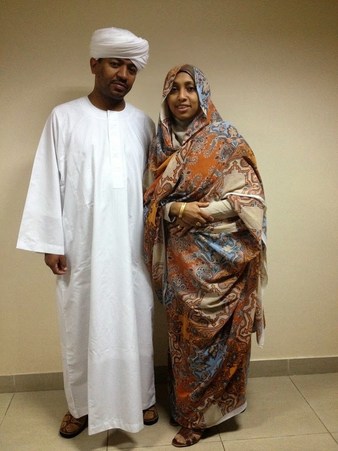
Sudanese men are often dark-skinned, with black African or Arab features. At the weekend and on special occasions, they wear a wide-sleeved thobe called the ‘Jallabiya’ and an ‘Imma‘ or turban.

Egyptians, Syrians, Jordanians and Lebanese wear semi-formal shirts and trousers and you can usually distinguish them by the differences in their Arabic accents. After work and at the weekend you will see the ‘Sham’ Arabs wearing short-sleeved, colored, cotton thobes in the mosques and out and about the town.
However, short-sleeved thobes became illegal in the kingdom as of Nov 2019.
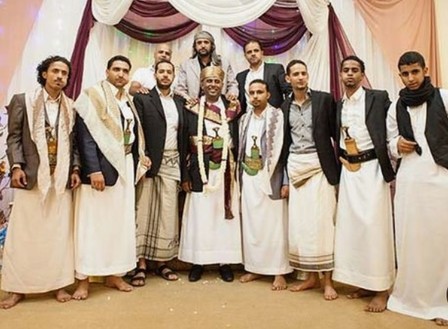
(3rd & 6th from the left)- Courtesy: apogeephoto.com
Fourth, the Yemenis are similar in appearance to the Saudis because they are from the Arab peninsula and ethnically of common origin. However, a Yemeni in addition to the ‘thobe’ likes to dress in a traditional Yemeni ‘Izhar’ a favorite piece of clothing worn by Prophet Mohammed (SAW) himself

Finally, Westerners and the Philippine people almost wear formal, semi-formal or casual type Western clothing. You can, of course, distinguish a Western person from his coloring white or black. The Philippine people are usually short, clean in appearance and have a distinctly Asian appearance.
In general, this is how you can normally tell people apart in the Saudi kingdom in terms of the clothes and know them from the types of clothes they like to wear.
Saudi or non-Saudi
In general, Saudi nationals have high self-regard and are dress conscious. This is reflected in both the laws about clothes and the attitudes they hold. You can, of course, tell a man is a Saudi by the way he dresses.

On his body, he wears a beautifully tailored white, cotton tube-like shirt which reaches to the feet called the ‘thobe‘. On his head, he wears a ‘taghheeya’ which is a white cotton tight-fitting hat. Over that he puts on a ‘shamag’ or ‘keffiya’’ which is a traditional wide red and white or plain white, cotton head covering. To hold it in place, he also wears, an ‘agal’, a circular weighted rope. Religious men generally do not use the ‘agal‘.
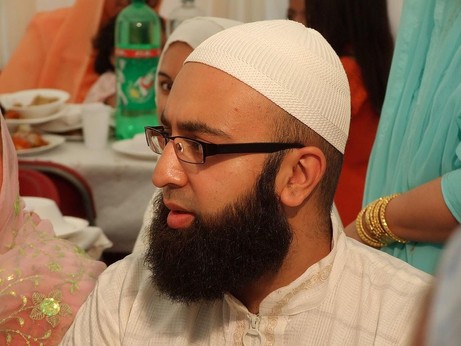
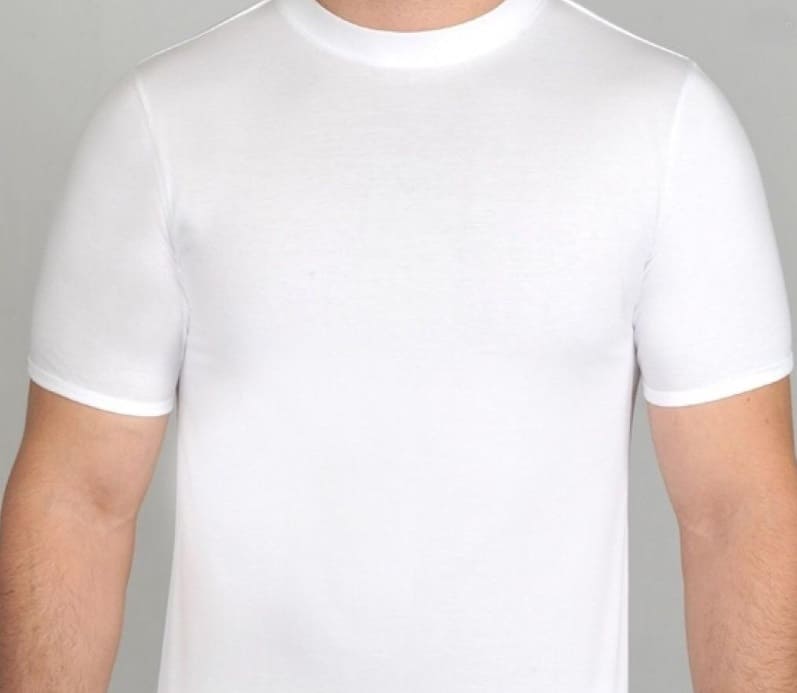
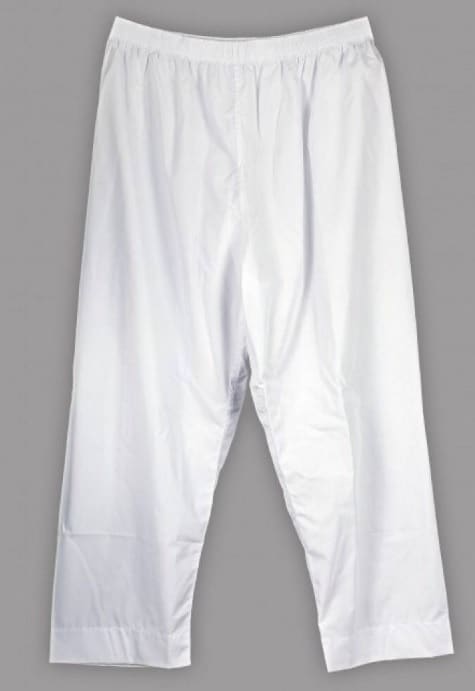
Under the thobe, he wears a ‘fanela‘, a short-sleeved vest. On his legs, he wears a white cotton ‘sirwel’ or cotton under trousers and light white cotton underwear. On his feet, he wears soft shoes or open leather sandals.

His accessories include a ‘sebha’ prayer beads, ‘oud’ perfume and a ‘bisht’ or ‘’mishla’ for Friday prayer or formal occasions.

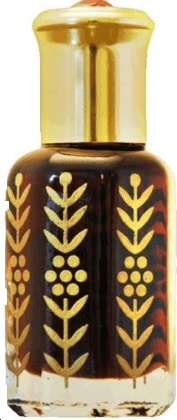
This official dress is very important to Saudi people. With it, they distinguish themselves in terms of their national identity and it helps to generate feelings of national pride and belonging to the nation of Saudi Arabia. MFS
The dress is beautiful, but it is not always very practical. In the modern world, it is difficult to do many kinds of jobs and tasks that the modern workplace demands- not least of all because it is easy to get the ‘thobe’ dirty and the headgear can get in the way of operating machinery and falls off with excessive movement.
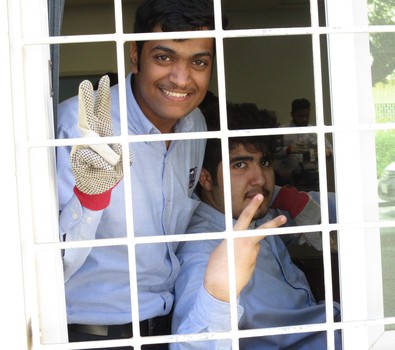
Today, in factories, plants and workplaces, Saudi workers wear a rugged shirt, trousers and safety shoes etc. Unless you are employed in government, a shop or in an office environment where the official dress is a must, the usual dress code for Saudi men is a shirt and trousers.

Though the ‘thobe’ is clearly the most popular form of dress for Saudi men increasingly young people are choosing to wear informal, fashionable clothes.
This often includes designer labeled pants, shirts, and baseball-type caps. It is understandable because it is the most common type of clothing in the world for young men in the world today and perhaps it is the most comfortable too. Young Saudis are very fashion-conscious and like to follow trends as in any other country.
What Should Male Visitors or Tourists to the Saudi Kingdom wear?
I think it is clear by now that as a man, what you decide to wear in Saudi Arabia as a visitor or a tourist will very much depend on the demands of the workplace, your activities and personal preferences.
However, before you decide what you pack before coming to Saudi Arabia, you would be advised to consider the following.
The ‘Awrah’ or the intimate parts of the body
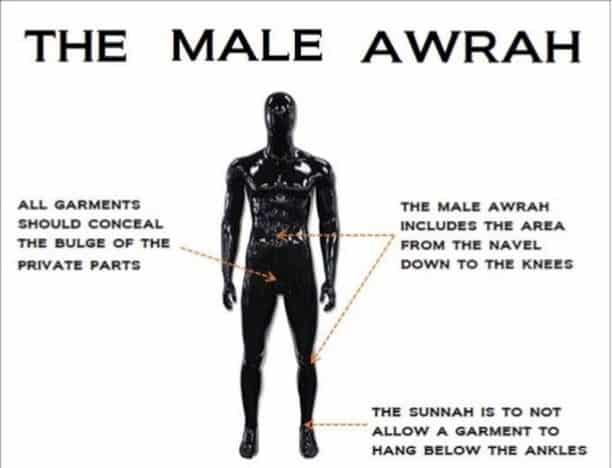
Though styles may vary, in order to ensure public decency every country has a code of dress indicating what is acceptable or unacceptable as forms of dress in any situation.
Unless you were completely home alone, in any country you would not walk around naked in public. For obvious reasons, the laws in any country simply do not permit this.
This is also the case in an Islamic country, except that, unlike elsewhere, the laws determining acceptable ways of dressing do not change. In Islam, it is based on the concept of ‘awrah’ or certain standards of what is considered decent.

In Saudi Arabia, just as there is an acceptable dress code for women, one exists too for men. This means that the clothes you wear should adequately cover your ‘awrah’ or certain ‘private’ parts of the body.
For men in Islam, the ‘awrah’ is the area starting just above the belly button and ending to just below the knees. The form of dress for men anywhere in the Islamic world must conform to this norm for it to be either legally or socially acceptable.
A ‘thobe‘ or loose pants with a shirt are acceptable dress forms because they adequately cover the belly button and extend to below the knees.
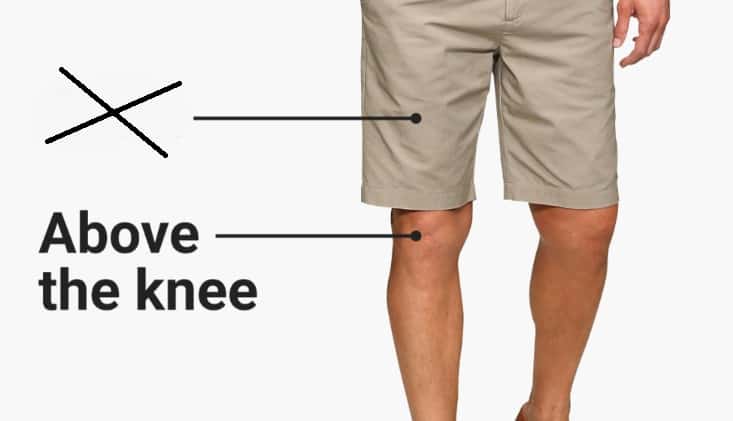
For this reason, wearing bathing trunks and shorts pants with legs that end above the knees are expressly forbidden and very much frowned upon in Saudi Arabia and by Muslims in the Arab world general. Various ‘Fatwas‘ exist condemning such wear.
Even at the beach, bathing trunks are not acceptable forms of dress because they do not adequately cover the area of the body considered to be ‘awrah’ for men.
Very often foreign, non-Muslims find this very difficult to understand since in their own countries no such concept or prohibition exists.
I frequently find my self explaining this to non-Muslim, usually Western men in Saudi Arabia who walk around on beaches in bathing suits or in public areas with very short pants. Wearing such clothes in these environments is quite provocative and blatantly insensitive.
Such people may get angry, defensive and object when they are stopped by embarrassed security guards and malls in public places. They do not normally speak English and find it difficult to confront such men wearing too short in the leg trousers.
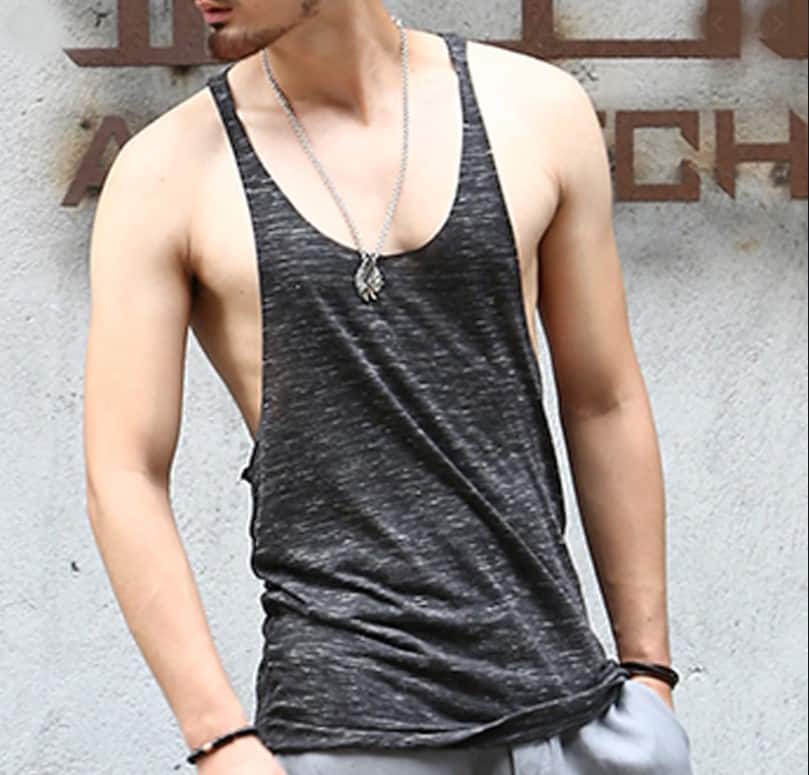
However, Saudis and the majority of expat Muslims do not like it and find it quite offensive. They often ignore and tolerate men wearing short pants because they believe that such people do not know any better. However, inside themselves, they feel repulsed and dislike it very much.
Actually, as of Nov 2019, partial nakedness as in the photo above and wearing shorts that end above the knees is illegal and will get you fined.

Wearing Necklaces and Bracelets are Prohibited for Men
In Saudi Arabia, Muslim men wearing any form of necklaces and bracelets whether gold, silver, leather or fiber is completely prohibited. Out of ignorance of the laws, some Muslim men do so, but it is entirely unacceptable.
However, men are permitted to wear a silver ring on the right hand in the manner of Prophet Mohammed (SAW) as it is part of the Islamic ‘sunnah’ or the Muslim way of life. But wearing bracelets, bangles and necklaces are considered effeminate and womanly. Imitating women in such ways is considered ‘Haram‘ (prohibited) and it is undignified and repugnant to Muslims.
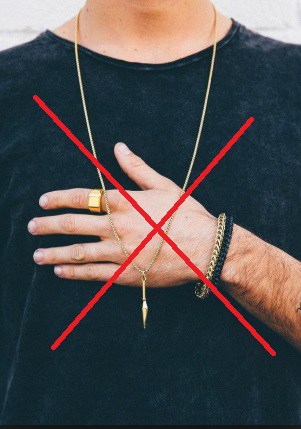
Important Notice- NEW Public Decency Legislation For 2020 And Beyond
New legislation regarding public decency that was passed by Saudi Arabia’s Council of Ministers (April 2019) is now being actively implemented by the police, government authorities and private security companies.
The new legislation is intended to regulate the public behavior of Saudi nationals, expat residents, visitors and tourists in accordance with the prevailing Saudi customs, values, and culture.
The prohibition targets individuals who wear ‘indecent’ or revealing clothing or garments with pictures, prints, signs or phrases that contravene standards of public decency.
Additionally, it bans acts of graffiti in public places, transport, buses and any instance of verbal intimidating and/or threatening behavior & writing.
The Saudi Ministry of the Interior determines the types of violations and corresponding fines. To date, there are 19 possible violations that range from SR50 ($14) up to SR 3,000 ($800) penalties.
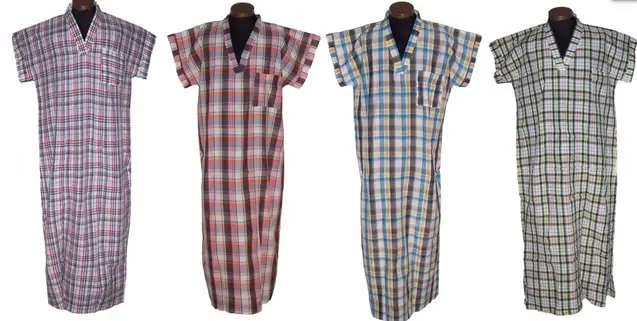
They include:
- Sexual Harassment of People In Public
- Displays of Physical Affection Between The Sexes
- Playing Loud Music In Residential Zones
- Playing Music During The Time Of Salat (Prayers)
- Throwing Litter
- Failure To Remove Dog or Animals Excrement
- Occupying Car Spaces Seats Intended For People With Disabilities
- Jumping Traffic Cones and Barriers In Public Places
- Wearing Undergarments, Pyjamas or House Thobes (Long Short Sleeved Garments) & Clothes that Reveal the Upper/Forearms & below the Knee (awrah)
- Wearing Shirts That Display Images of Nude Bodies
- Wearing Shirts or Clothes With Phrases that Contravane Public Decency
- Graphitti in Public Places
- Offensive or Racist Stickers on Cars
- Leafletting without a license
- Making Open Fires in Official Picnic Areas
- Making Verbal Threats or Threatening or Offensive Gestures
- Jumping Lines at Public Events
- Shining Laser Pointers into People’s Eyes
- Photographing Others Without Their Permission.
- Photographing Traffic Accidents without Permission of Parties Involved in The Accidents
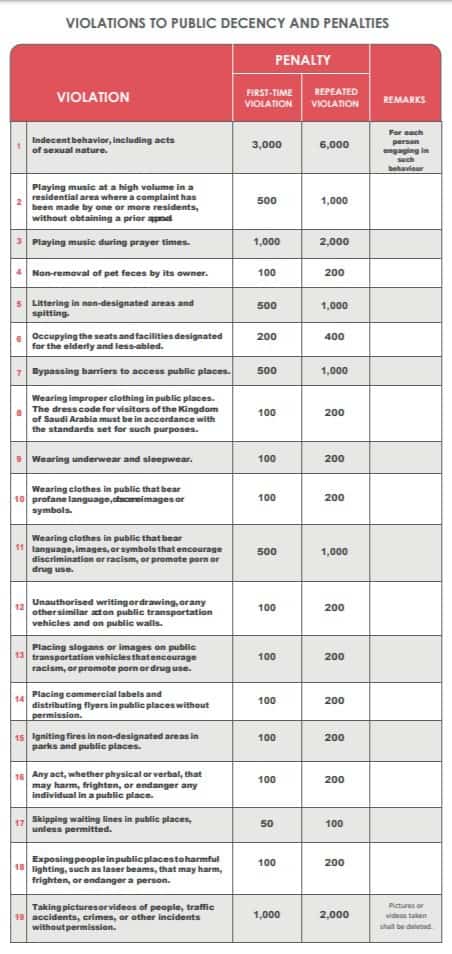
Since December 2019, I know of a number of cases of Egyptian nationals who are receiving fines of SR 100 for wearing the traditional ‘galabeya’ thobe in public which in Saudi Arabia are considered as bedroom wear.
Non Arab Visitors and Tourists Wearing Saudi or Arab Clothing

Note that It is permissible and acceptable for non Arab, non-Muslim men to wear the traditional ’thobe’ and ‘shamag’. Though a little unusual. Saudi men really like and welcome it. They understand that you are a foreigner and feel delighted when you pay them the compliment of wearing their traditional clothes.

In fact, I myself wear the traditional ‘thobe’ and ‘shamag’ exclusively at work because I am a college teacher and I find them very elegant and comfortable in the classroom and the office.
For these reasons, many non-Saudi Muslims of all nationalities also choose to wear it too, particularly Muslim converts.
How to Buy a Thobe
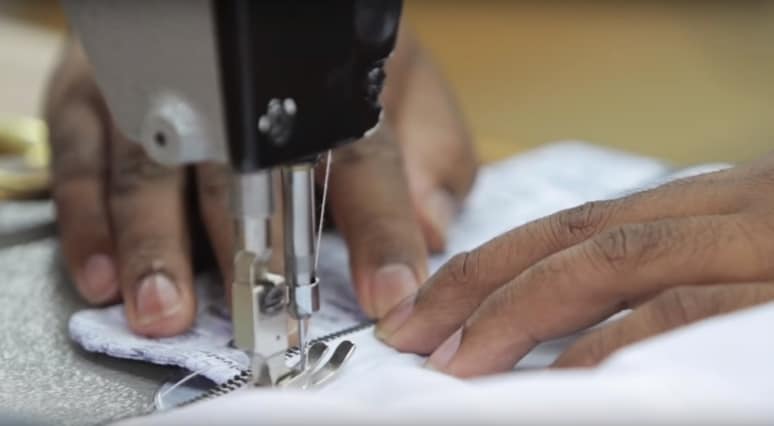
Buying a ‘thobe’ in Saudi Arabia is very much like the way you might buy a formal suit. You can get it straight off the shelf or have one made to measure.
First, decide on the type of ‘thobe‘ you want. In most men’s clothes shops, you will find long and short-sleeved house ‘thobes‘ and more formal long-sleeved white thobes for purchase for summer and winter.
If you chose to buy straight off the shelf, the sizes on the labels of the ‘thobe‘ refer principally to your height measured from the shoulders to the ankles. So, if your height, for example, is 61cm, then buy a thobe with the same number in either small, medium or large sizes.
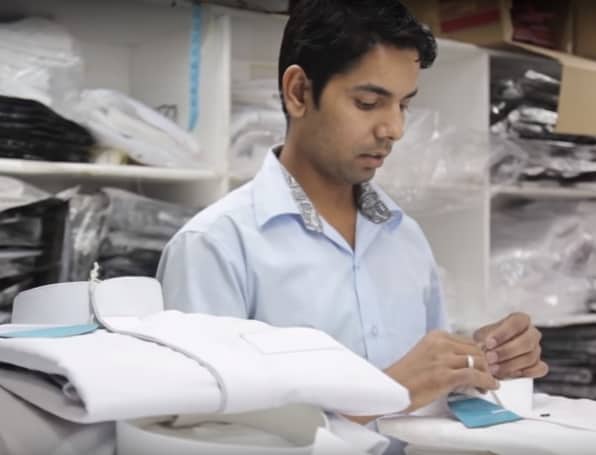
If you go for the handsewn option, then you should visit a ‘thobe‘ tailor shop. Here, the tailor, usually an expat, will take your body measurements, then ask you to chose the fabric and design. After measuring your arm length, chest, waist, trunk and legs and neck, you pay a small deposit and wait for a few days for him to freshly ‘tailor’ you a nice thobe.

At the same time, you may wish to buy accessories such as a ‘tagheer’ (hat) a ‘shamag’, (head covering) and an agal, (circular headpiece). Try them all on in the shop first before you buy to get the right fit and feel.
Below is a lost of traditional men’s wear in Saudi Arabia and the general price ranges.
| No | Item | Type | Price |
| 1 | House Thobe | Short-Sleeved | 50SR |
| 2 | House Thobe | Long-Sleeved | 60SR |
| 3 | White Thobe | Off Shelf | 80SR |
| 4 | White Thobe | Tailored | 150- 300SR |
| 5 | Winter Thobe | Tailored | 200SR |
| 6 | ‘Shamag’ | Off shelf | 40- 200SR |
| 7 | Tagheer’ (hat) | Cotton | 10SR |
| 8 | Agal | Rope | 50SR |
| 9 | Bisht | Cotton | 100SR |
| 10 | Bist | Wool | 400SR |
Related Questions
Must Saudi men always wear traditional Saudi clothes? No, as long as they dress conservatively any kind of clothes are permissible for Saudi men. At school, boys can wear a ‘thobe‘ or casual clothing. In the workplace, wearing both traditional and semi-formal clothes is usually fine. However, when attending government offices, job interviews and formal events, Saudi men must wear the official white ‘thobe” and ‘shamag‘. MFS
How Must Women Dress in Saudi Arabia? All women should dress modestly in public and for Muslims wear the Islamic ’abaya’ a black wrap that covers the trunk, arms and legs. Muslim women are also expected to cover the head using a hijab, headscarf, but not necessarily the face. Non-Muslim women can leave the head, hair, hands and feet uncovered. They DO NOT need to wear abayas but should dress respectfully and not reveal body parts.
